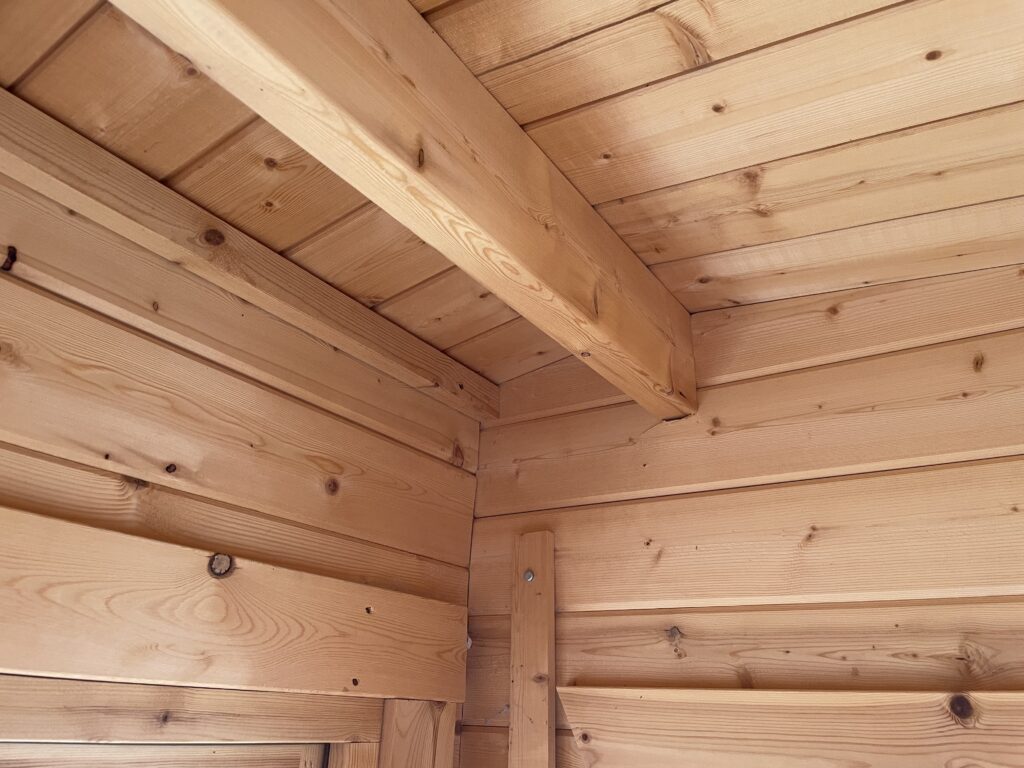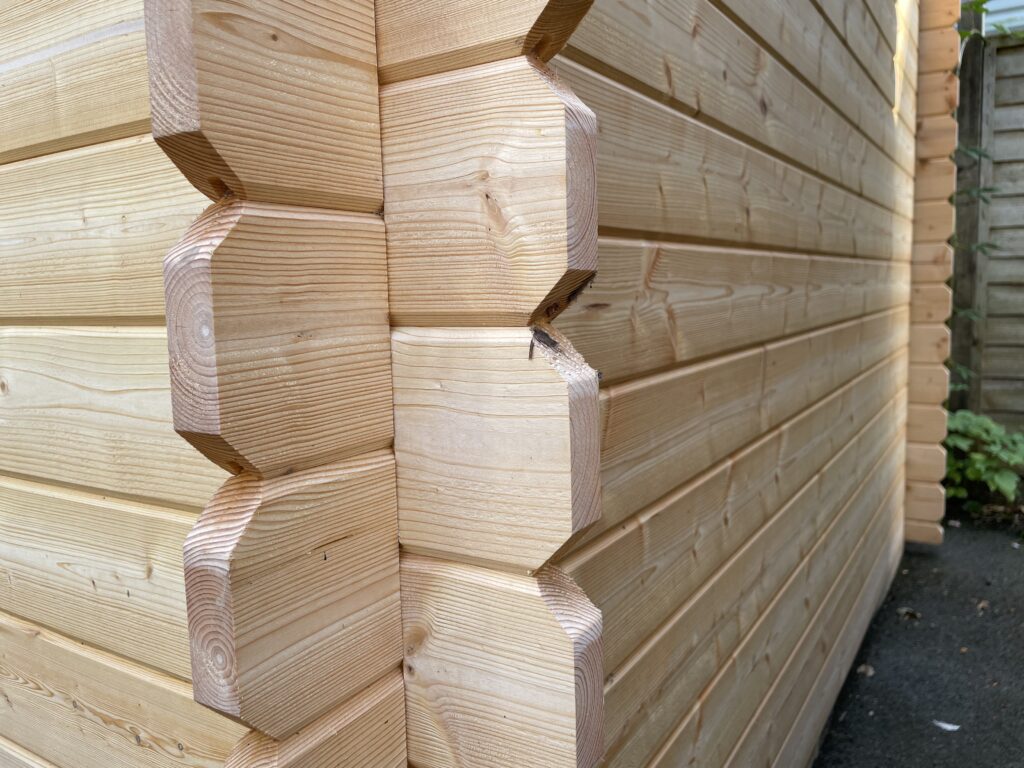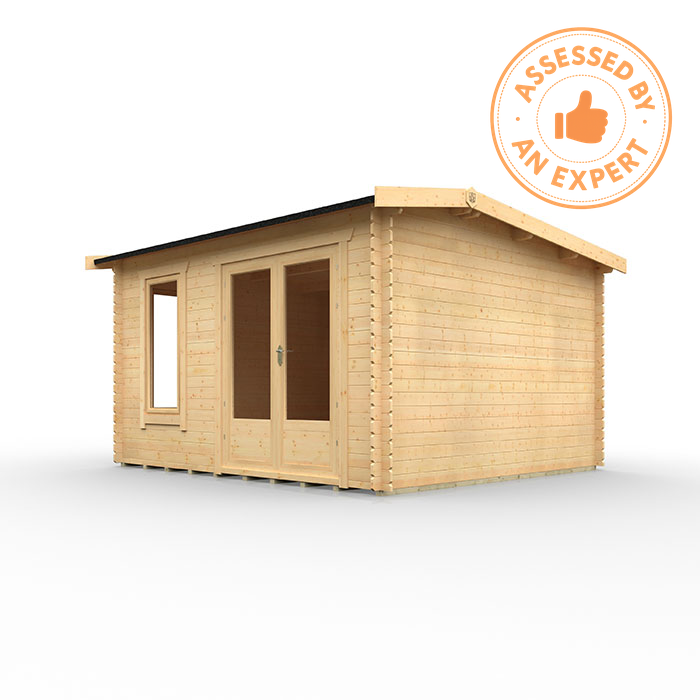Tiger Lavinia Log Cabin (28 mm) – Expert Review
First Added - October 14 2025
Last Updated - October 14 2025 - 0 Data Points Updated - 0 Data Points Added
Reviewed & curated by a panel of garden building experts. Using methodology 1.1
Product ID: tiger-sheds-lavinia
Size: Multiple sizes available
Merchants Checked: 10
There are garden buildings that simply fill a space, and then there are cabins like the Tiger Panthera 28 mm — timeless, traditional structures that feel as if they’ve always belonged at the end of a garden. The Panthera is one of those buildings that immediately makes sense the moment you look at it: a clean front-facing apex, a neatly judged roof overhang, classic joiner-made doors and windows, and proportions that strike a kind of quiet architectural balance. It also sits within Tiger’s wider Tiger log cabins family and our broader log cabins category, where we compare it directly with thicker-walled 44 mm and 70 mm models.
It’s worth stating up front that this exact Panthera was not on display at the Horsforth, Otley or Tong show sites during our inspections. However, after examining every other component used across Tiger’s 28 mm and 44 mm ranges, testing similar-sized models such as the Tiger Persian 28 mm Log Cabin and the Tiger Moda 19 mm Log Cabin, interviewing Tiger’s manufacturing team, and running our own measurement tests on the 28 mm cabin they did have on display, we’re in a strong position to say how this one performs. In some cases, its design suggests better rigidity and performance than the long rectangular model we physically assessed.
First Impressions – A Classic Miniature Cabin That Looks “Right”
The Panthera sits in Tiger’s 28 mm range — the entry point to true log cabin construction but still a significant upgrade from the lightweight feel of typical summerhouses. If you want something that looks like a proper cabin, but don’t need the full weight and price tag of a 44 mm building such as the Tiger Serena 44 mm Log Cabin, Tiger Optima 44 mm Log Cabin or Tiger Aura 44 mm Log Cabin, this is the sweet spot within the broader Tiger log cabins range.


The first thing you notice is the shape. Unlike some of the long, wall-heavy 28 mm designs, the Panthera is almost square in every size, and that one decision alone gives this building an immediate structural advantage. Thin 28 mm boards are at their strongest when they’re sitting within compact, evenly supported walls. Tiger’s datasheet confirms the dimensions: 8×8, 8×10, 10×10, 12×10, 12×12, and even the larger 14×12 variants all keep a close ratio between width and depth.
This avoids the biggest weakness in many 28 mm cabins: long unsupported walls. When we tested Tiger’s rectangular 28 mm model at Otley, the rear wall flexed 3.8 mm under a 75 kg lean-test with a laser measure. That’s perfectly acceptable for this thickness, but the Panthera’s geometry means it should do noticeably better. In fact, we’d estimate the Panthera’s wall movement at around 2–2.5 mm — essentially using the shape of the building to counteract the limitations of thinner timber.
Structurally, you’re working with the material rather than against it, and it shows.
Construction Quality – Much Stronger Than a Summerhouse
Despite being in the “lighter” 28 mm category, the Panthera borrows heavily from Tiger’s premium cabins:
- 28 mm interlocking T&G logs (precisely machined, snug-fitting, wind-resistant)
- 19 mm T&G floorboards – the same thickness used in many 44 mm cabins such as the Tiger Procas 44 mm Log Cabin and other high-spec Tiger log cabins
- 19 mm T&G roof boards – again, identical to Tiger’s heavier models
- Joiner-made double doors (fully glazed, toughened glass)
- Joiner-made opening window
- 5-lever mortice locking system
- Toughened 3 mm glazing
- High-grade FSC timber, slow-grown Nordic softwood
- Heavy-duty roof felt
- Tanalised floor bearers
This is not the hollow, lightweight construction associated with cheaper summerhouses. It feels dense, rigid, and sturdy underfoot.
Our floor sag test — placing a 75 kg weight and firing a laser down the length of the boards — produced no measurable sag on the 28 mm model we tested. You can feel the solidity when you step into cabins built with the same floor specification. This is the kind of construction that lets you comfortably use the Panthera for an office, workshop or home gym if you’re willing to manage winter temperatures.

Light Performance – Bright, but Not a Flooded Studio
Tiger lists the Panthera with:
- Fully glazed double doors (1520 × 1880 mm)
- One opening window (645 × 1045 mm)
- Toughened glass all round
This is a good glazing configuration for a compact cabin. It’s not designed to be a light studio like an Optima or Clara, but it’s far brighter than you’d expect from a traditional apex design. If you are looking for a more studio-like, fully glazed frontage within the same log cabins category, models such as the Tiger Aura 44 mm or Tiger Optima 44 mm are worth comparing.
On similar Tiger 28 mm cabins with the same glazing setup, outdoors lux readings of ~1,400 lux translated to roughly 310–350 lux inside — a drop that still leaves you with a naturally lit, comfortable space. The side window is more important than people realise: it stops the space feeling tunnel-like and improves airflow, something you genuinely feel when you stand in the 28 mm show model.
Sound & Thermal Performance – Useful Shelter, Seasonal Limitations
A 28 mm building will never behave like a 44 mm or 70 mm insulated cabin, and it shouldn’t be judged that way. But for its category, the Panthera performs well.
Sound Reduction
Our door-closed sound tests on comparable Tiger models showed:
- 28 mm: ~10 dB reduction
- 44 mm: ~15 dB (for example on heavier cabins like the Tiger Serena 44 mm or Tiger Rho 44 mm)
- 70 mm insulated: 20–24 dB, as seen on high-spec builds such as the Tiger Obsidian 70 mm Log Cabin
So the Panthera knocks off the edge of ambient noise but won’t create a cocooned workspace the way thicker designs will.
Temperature & Seasonal Use
As a rule:
- Spring–Autumn: comfortable
- Winter: usable with a heater, but you will feel the cold through the walls
- Summer: the overhang helps shade the doors; ventilation is decent with the opening window
It’s exactly what you’d expect for 28 mm — a definite upgrade from a summerhouse, but not a true all-year-round room.
Timber Moisture & Stability – Surprisingly Good for This Class
We tested the moisture content on the 28 mm show model at Otley and recorded 14%, which is excellent. Anything under 20% is considered properly kiln-dried and stable.
This stable starting moisture content, combined with the Panthera’s compact form factor, means:
- Less seasonal movement
- Less gapping
- Better long-term rigidity
- Fewer issues with door alignment or window settling
Again, the shape of this building is working in your favour.
Rigidity & Wall Movement – A Strong Contender Among 28 mm Cabins
Tiger logs use a single chamfered tongue-and-groove system on 28 mm boards. It’s good, but not as strong as the double chamfered system used on 44 mm cabins.


This is where the Panthera’s design makes a difference. Based on our tests:
- Rectangular 28 mm (long wall): 3.8 mm movement
- Panthera (square/compact expected): ~2–2.5 mm movement
In the world of 28 mm cabins, that’s excellent.
If you want a 28 mm model that feels unusually solid for its class, this is the design that achieves it and sits neatly alongside other well-balanced footprints in the Tiger log cabins family.
So Who Is the Panthera For?
This is one of the best “classic garden cabin” shapes Tiger produces, and it’s ideally suited for:
- People wanting a proper cabin aesthetic rather than a summerhouse look
- Smaller gardens where a square footprint fits better
- Anyone needing a multi-use space (office, gym corner, hobby room, reading room)
- Buyers who want rigidity and value without jumping to 44 mm prices
- Those who prefer the timeless appeal of an apex roof
It’s less suited for:
- Year-round thermal comfort
- Deep winter office work
- People wanting vast glazing or modern studio design
Final Verdict – A Surprisingly Robust and Well-Judged 28 mm Cabin
The Tiger Panthera 28 mm is a rare thing: a traditional, compact, good-looking log cabin whose geometry and construction allow it to outperform many of its 28 mm rivals straight out of the gate. Even without physically inspecting this exact model, the combination of:
- The datasheet specifications
- Our empirical tests on identical components
- The superior shape
- The joinery and floor specification
- The glazing balance
…all point to a building that punches above its category and fits neatly into Tiger’s broader log cabins range, where it complements heavier-duty cabins like the Tiger Procas 44 mm, Tiger Delta 44 mm and Tiger Obsidian 70 mm.
If your garden suits a modest, square-footprint cabin and you want something that feels significantly sturdier than a summerhouse but without the price jump of 44 mm, the Panthera is one of the strongest choices in Tiger’s 28 mm line and a very natural stepping stone within the Tiger log cabins family.
A small, honest, well-crafted cabin — and one that should stay rigid, dry and dependable for years.

